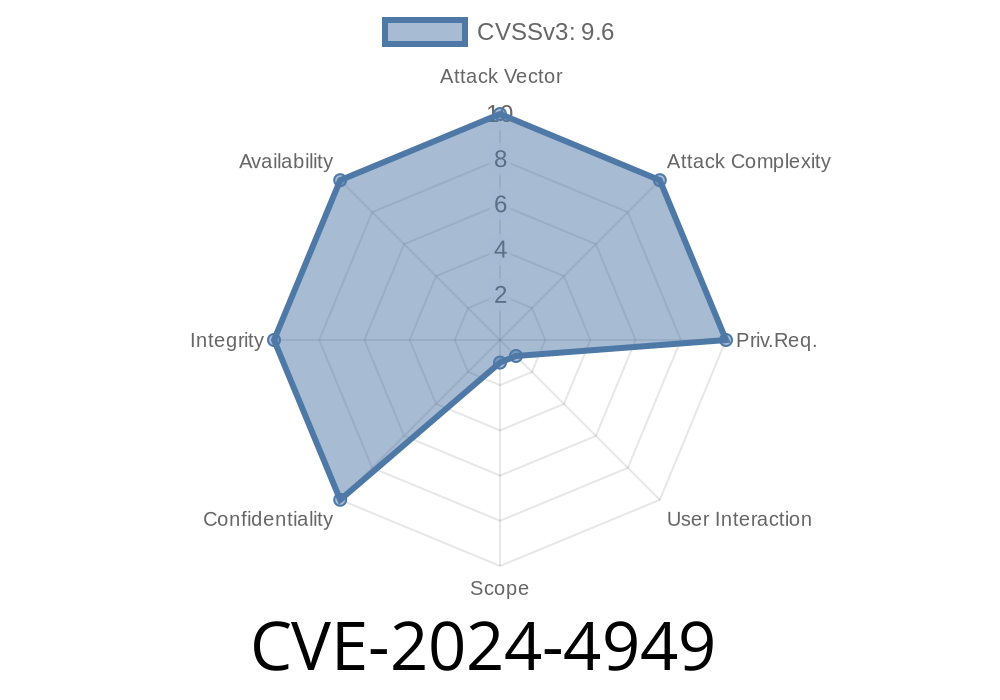CVE-2024-4949 is a recently discovered vulnerability that affects Google Chrome’s JavaScript engine, V8, in versions earlier than 125..6422.60. This flaw, categorized as a "use-after-free," can let a remote attacker cause heap corruption and potentially execute malicious code simply by luring a user onto a crafted web page.
Let’s break down the vulnerability, explore a code example, and discuss what you can do to stay safe.
What Is a Use-After-Free Bug?
A use-after-free (UAF) happens when a program continues to use memory after it's been freed. In browsers, this can be quite dangerous. Attackers can use this gap to inject their own code into freed areas, which can lead to anything from browser crashes to full-on malware infections.
Where Did It Happen? (V8 in Chrome)
V8 is the piece of Chrome that crunches JavaScript. The bug affects users of Chrome before version 125..6422.60 on all major platforms. The bug's medium severity is still serious—remember, Chrome is one of the most common browsers around.
Impact: Heap corruption, possible code execution
Official link:
- Chromium Bug Tracker Issue *(may be restricted)*
- NVD CVE-2024-4949 Entry
How Could an Attacker Exploit This?
An attacker could host a website designed to trigger the vulnerable behavior in V8, causing Chrome to access or execute code in freed memory regions. They just need you to visit their site.
Simplified Exploit Example
While full proofs-of-concept are not open for public safety, here’s a simplified JavaScript example that shows the essence of use-after-free issues in V8 engines (not an actual weaponized exploit, for learning purposes only):
let victim;
// Create an ArrayBuffer and then detach it
function triggerUAF() {
let arr = [1.1, 2.2, 3.3];
function free() {
victim = arr;
arr = null; // Remove reference, expecting garbage collection
}
free();
// Force garbage collection (not always possible in real world JS)
for (let i = ; i < 10000; i++) {
let tmp = new ArrayBuffer(x10000);
}
// Now, the old memory for arr may be freed and reused. Accessing 'victim' here is a UAF scenario.
// In real exploit, this may let attacker plant malicious objects into the freed space.
console.log(victim);
}
triggerUAF();
Note: Modern JavaScript doesn’t give direct control to memory management or garbage collection. But V8’s just-in-time compiler and objects can sometimes be coerced into these dangerous states.
A real attack requires sophisticated heap spraying and timing, way beyond this demonstration. Security researchers often use bugs like this to take control over Chrome’s behavior in memory.
What Should You Do?
Update Chrome NOW
If you’re on a version lower than 125..6422.60, you're at risk. Chrome updates are fast and automatic, but double-check:
- Go to chrome://settings/help
References
- Chrome Release Notes: Stable Channel Update for Desktop
- NVD Entry: CVE-2024-4949 on NVD
- Chromium Security Page: Security Issues in Chromium
- V8 Security: V8 JavaScript Engine Security
Final Thoughts
CVE-2024-4949 is a reminder of how complex and fragile browser security is. While Google’s team patched the issue quickly, attackers are often quick to reverse-engineer and weaponize these bugs. Keep your browser fresh. Stay careful online.
If you want to dig deeper, monitor the Chromium bug tracker (although bugs are often kept private until the patch is widely distributed for user safety!).
Timeline
Published on: 05/15/2024 21:15:09 UTC
Last modified on: 07/03/2024 02:08:21 UTC
